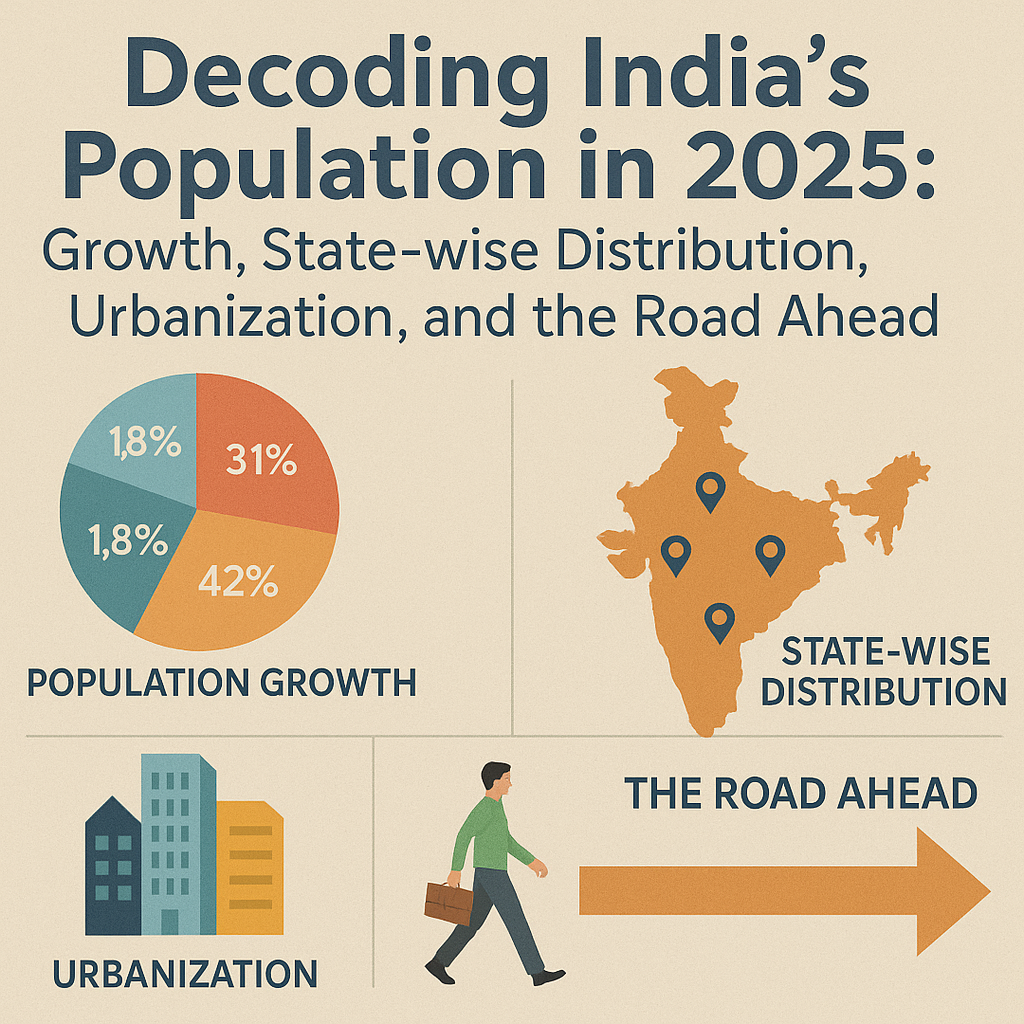India, the world's most populous country in 2025, has always stood as a demographic giant. From the bustling streets of Mumbai to the quiet corners of Sikkim, the population dynamics of this nation of over 1.43 billion people reflect deep social, economic, and political complexities. In this decoded report, we dive deep into India's latest population data—exploring growth, state-wise distribution, urban trends, youth power, challenges, and opportunities.
India's Total Population in 2025: The World's #1
According to UN and World Bank estimates, India has officially surpassed China in population, reaching an estimated 1.42–1.43 billion people by mid-2025. This translates to 142–143 crores, making India the most populous nation on Earth.
India's annual growth rate has moderated to 0.9%, yet the sheer size of its base makes even marginal growth impactful. The median age is around 29 years, making India one of the youngest large economies globally.
State-Wise Population Breakdown (2025)
Population distribution varies dramatically across states. According to projections based on census data and updated estimates:
| Rank | State | Estimated Population |
|---|---|---|
| 1 | Uttar Pradesh | 22.9 crores |
| 2 | Maharashtra] | 12.1 crores |
| 3 | Bihar | 11.9 crores |
| 4 | West Bengal | 9.8 crores |
| 5 | Madhya Pradesh | 8.2 crores |
| 6 | Rajasthan | 7.8 crores |
| 7 | Tamil Nadu | 7.6 crores |
| 8 | Karnataka | 6.6 crores |
| 9 | Gujarat | 6.4 crores |
| 10 | Andhra Pradesh | 5.3 crores |
| States like Kerala, Telangana, and Haryana follow closely behind. |
Urban vs Rural: The Great Demographic Divide
India’s population is still predominantly rural, but the urban tide is rising.
- Urban Population (2025):
36% (52 crores) - Rural Population:
64% (91 crores)
Urbanization hotspots include Delhi, Bengaluru, Hyderabad, and Ahmedabad.
Most Populous Cities in India (2025 Estimates)
| City | Estimated Population |
|---|---|
| Mumbai | ~2.1 crores |
| Delhi | ~1.8 crores |
| Bengaluru | ~1.4 crores |
| Kolkata | ~1.3 crores |
| Chennai | ~1.2 crores |
| Hyderabad | ~1.1 crores |
| Ahmedabad | ~90 lakhs |
| Pune | ~75 lakhs |
| These metros are growth engines but also under immense pressure for infrastructure, water, housing, and transport. |
Religion-Wise Population Distribution
India is home to multiple religions coexisting across regions. As per projected estimates:
| Religion | % Share of Population |
|---|---|
| Hindu | ~78% |
| Muslim | ~14.2% |
| Christian | ~2.3% |
| Sikh | ~1.7% |
| Buddhist | ~0.7% |
| Jain | ~0.4% |
| Others | ~2.0% |
| Diversity is a strength—but also a responsibility for balanced policy and representation. |
Age Pyramid: India’s Demographic Dividend
India’s working-age population (15–64 years) forms nearly 67% of the total population. Here's how the rest is split:
- Children (0–14 years): ~26%
- Seniors (65+ years): ~7%
This massive youth base is India’s biggest opportunity—but only if supported by quality education, employment, and healthcare.
Literacy and Education Trends
- Literacy rate (2025 est.): ~79%
- Highest literacy: Kerala (~96%)
- Lowest literacy: Bihar (~65%)
Education remains a transformative tool for uplifting underdeveloped regions.
Internal Migration Trends
Internal migration is reshaping the urban fabric of India:
- Rural youth are moving to cities like [Pune(https://ragadecode.com/locations/india/maharashtra/pune), Gurugram, and Hyderabad for jobs.
- States like Uttar Pradesh, Bihar, and Odisha are major sources of migrant labor.
- Kerala and Tamil Nadu attract interstate migrants due to industrial growth.
Government Policies on Population Control
India has taken a soft policy stance post-2000s:
- Incentives for smaller families
- Awareness campaigns in states like Rajasthan, Madhya Pradesh, and Uttar Pradesh
- Health mission programs to reduce maternal & infant mortality
Unlike China’s now-abolished "one-child" policy, India relies on voluntary participation.
Challenges India Faces with a Massive Population
- Job Creation: Every month, India needs to create 1 million+ jobs to absorb its youth.
- Urban Infrastructure: Cities like Chennai, Ahmedabad, and Kolkata face huge urban congestion.
- Healthcare Access: Rural states like Jharkhand, Chhattisgarh, and Assam need urgent infrastructure support.
- Climate Pressure: Densely populated states are highly vulnerable to climate events.
Opportunities: Why This Could Be India's Moment
- Youthful Workforce: If skilled, India can be the back-office and innovation hub of the world.
- Rural Digitization: BharatNet and other projects are enabling rural participation in the economy.
- Tier-2 Growth: Cities like Madurai, Vadodara, and Narsinghpur are emerging tech and manufacturing hubs.
Future Projections: India 2030–2040
According to projections by the World Bank and UN:
- 2030: ~1.49 billion (149 crores)
- 2040: ~1.55 billion (155 crores)
- Population growth will plateau around 2050 and may begin declining slowly thereafter.
This gives India a 25-year window to capitalize on its demographic advantage.
Conclusion: The Population Engine Must Be Steered
India's population in 2025 is both a gift and a responsibility. It represents unmatched scale, energy, and diversity—but also tests the limits of infrastructure, governance, and social harmony.
As India marches forward, the question is no longer just about numbers—but about nurturing and unlocking the full potential of 1.43 billion citizens.
From Palakkad to Churu, from Trivandrum to Nagpur, the pulse of the country beats in its people.
India's future will be written not just by its size—but by how it uses it.
Sources: UN Population Division, World Bank, Census of India, NCRB Reports, DataCommons.org, studyiq.com, pw.live, Government of India Population Projections 2020–2040.
This decoded report is a part of the India Insight Series by Ragadecode.


